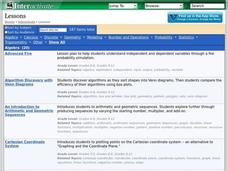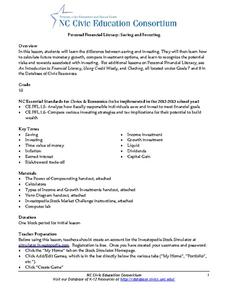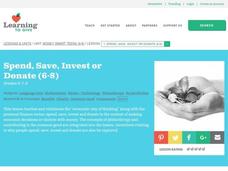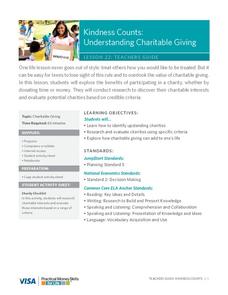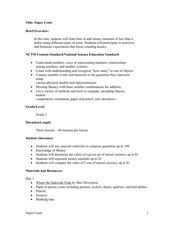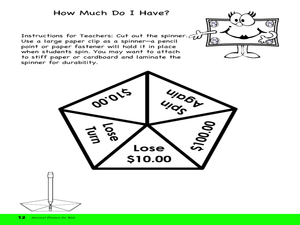Curated OER
Expected Value
Students explore expected value, are introduced to the concept of varying payoffs, and have used a computer simulation of a "real world" example where expected value is used
Curated OER
Multiplication and Areas
Upper graders solve problems involving measurement of squares and rectangles to practice multiplication skills, finding area, and calculating prices and percentages. A performance assessment is included.
Rainforest Alliance
Investments in Forest Carbon
One hundred metric tons of CO2 can accumulate in one acre of forest over time—that's a lot of carbon! In the activity, groups of middle school learners determine what makes forests important. They then solidify the concept by using a...
Carolina K-12
Personal Financial Literacy: Saving and Investing
When should you save, and when should you invest? In considering this question, your class members will also learn about the time value of money, inflation, compounded interest, and income/growth investments. The resource also outlines...
Charleston School District
Solving Systems with Elimination
Can you handle one more method? It just might be your favorite! Building on the skills learned in the previous lessons in the series, scholars now learn the elimination method. The video examines problems of varying difficulty.
Curated OER
The Renaissance
Get out a clean sheet of paper and get ready to take notes on the Italian Renaissance. Kids can easily follow along as you progress through each informative slide. They'll take notes on humanism, classical learning, city-states, and...
Curated OER
Spend, Save, Invest or Donate
Students explore the concept of philanthropy. In this personal finance lesson, students consider economic choices and why people donate to causes. Students investigate the processes of borrowing money and investing money in the lesson as...
Visa
Kindness Counts: Understanding Charitable Giving
Financial literacy is generally focused on personal spending and saving, but consider an opportunity to talk to your pupils about how charitable giving can also factor into money management and how it can enhance life for both...
Curated OER
Money for starters
Students compare the values of coins and paper money. They read prices, read and write any 2-digit number. They model and explain addition calculations with a sum of up to 20.
Curated OER
Trading Game
Students listen to story about money or coins, and play game to help them solidify their understanding of money. Students focus specifically on coin value and calculating amounts of money up to fifty cents or above, depending on level.
Curated OER
The Dollar Cookie
Second graders recognize, count, and write money amounts using the cent symbol and identify equivalent amounts of money. In this money lesson plan, 2nd graders add money amounts using plastic coins and magnetic money.
Curated OER
Periodic Table of the Elements
Middle schoolers experiment with transition metals. For this transition metals lesson students find the common properties of transition metals and conduct an experiment using one of them. Middle schoolers then answer...
Curated OER
Why Use Money? Getting What We Need
Middle schoolers learn the difference between purchase, barter, and payment for service, then explore how the Akan and North African people used a barter system to exchange gold and salt. They identify the most efficient ways of...
Visa
A Way to Wealth: Understanding Interest and Investments
Money motivates! Help young bankers understand how math plays a part in investing. Give learners math practice while instilling real-world financial literacy skills.
Curated OER
Money Makes the World Go 'Round
Young scholars examine what a basic unit of currency means and how it affects world finances.
Curated OER
Are You Money Smart?
Learners figure out and discuss the irony of this coin-centric poem. They also practice persuasive letter writing, and identify and count coin/money values.
Curated OER
Coin Content
Students calculate ancient Greek coin values as compared to their weight, equivalence in grain, and determine their worth today. They explain how to calculate fractions of a given weight and how to use decimal numbers.
Curated OER
Model Counting Pennies and Nickels
First graders provide monetary value of coins. In this counting pennies and nickels lesson, 1st graders practice counting money with a partner.
Curated OER
Adding Pennies, Nickels and Dimes
Learners add pennies, nickels and dimes and organize the coins to display a variety of price values from real life examples. They discuss the importance of money in the day-to-day world.
Curated OER
One Vs. One Hundred
Students explore the concept of place value. They differentiate between digits and their values as it related to addition and subtraction. Through the use of technology and manipulatives students investigate the place value of digits by...
Curated OER
Get Ready, Get Set, Squeeze!
Students explore coin value and count coin combinations. In this money counting and social studies lesson, students read The Coin Counting Book by Rozanne Lanczak Williams and practice counting money and making change for a lemonade...
Curated OER
Super Cents
Second graders study money amounts less than a dollar. In this math activity, 2nd graders practice counting coins. Students read various stories and discuss how money was used in the stories.
Curated OER
Wealth
Third graders read the story The Day I Was Rich and learn about the role of money and taxes. In this money lesson plan, 3rd graders count large sums of money, group them, and give it away in the form of taxes. They discuss wealth and how...
Curated OER
Penny, Nickel, Dime
Second graders recognize and compare the value of pennies, nickels, and dimes. They review counting pennies, nickels, and dimes.
